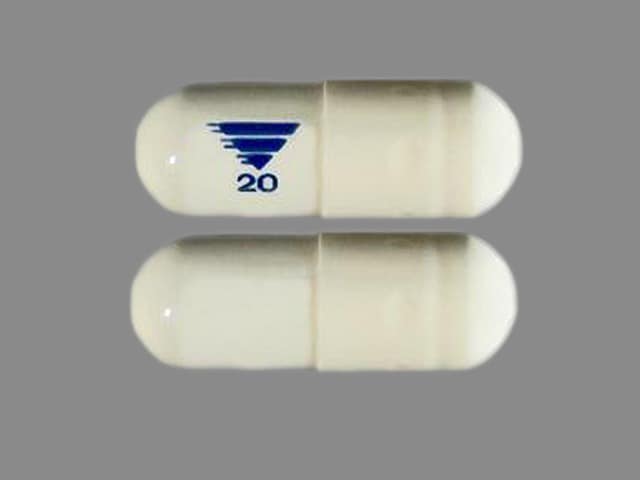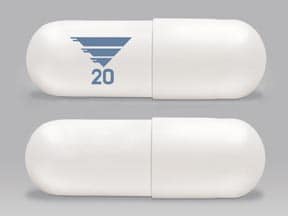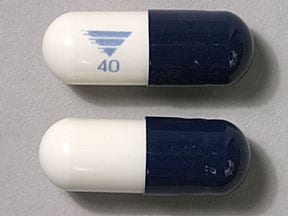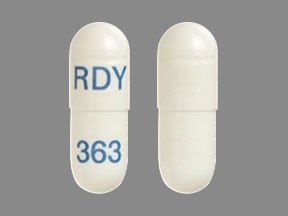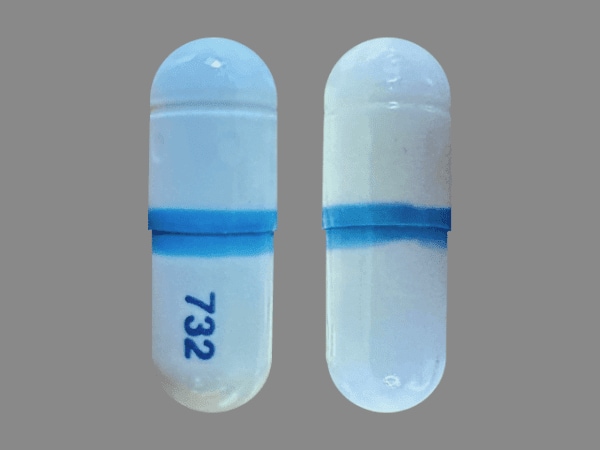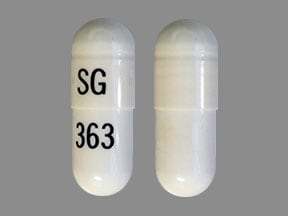Dosage Forms
Excipient information presented when available (limited, particularly for generics); consult specific product labeling.
Capsule, Oral:
OmePPi: Omeprazole 20 mg and sodium bicarbonate 1100 mg, Omeprazole 40 mg and sodium bicarbonate 1100 mg [contains sodium 304 mg (13 mEq) per capsule]
Zegerid: Omeprazole 20 mg and sodium bicarbonate 1100 mg, Omeprazole 40 mg and sodium bicarbonate 1100 mg [contains sodium 304 mg (13 mEq) per capsule]
Zegerid OTC: Omeprazole 20 mg and sodium bicarbonate 1100 mg [contains sodium 303 mg (13 mEq) per capsule]
Generic: Omeprazole 20 mg and sodium bicarbonate 1100 mg; Omeprazole 40 mg and sodium bicarbonate 1100 mg
Powder for suspension, Oral:
Zegerid: Omeprazole 20 mg and sodium bicarbonate 1680 mg per packet (30s) [contains sodium 460 mg (20 mEq) per packet]
Zegerid: Omeprazole 40 mg and sodium bicarbonate 1680 mg per packet (30s) [contains sodium 460 mg (20 mEq) per packet]
Generic: Omeprazole 20 mg and sodium bicarbonate 1680 mg per packet (30s); Omeprazole 40 mg and sodium bicarbonate 1680 mg per packet (30s)
Pharmacology
Mechanism of Action
Suppresses gastric basal and stimulated acid secretion by inhibiting the parietal cell H+/K+ ATP pump
Pharmacokinetics/Pharmacodynamics
Absorption
Rapid
Metabolism
Extensively hepatic via CYP2C19 primarily and to a lesser extent via 3A4 to hydroxy, desmethyl, and sulfone metabolites (all inactive); saturable first pass effect
Excretion
Urine (77% as metabolites, very small amount as unchanged drug); feces
Clearance: 500 to 600 mL/minute; chronic hepatic disease: 70 mL/minute
Onset of Action
Antisecretory: ~1 hour; Peak antisecretory effect: 2 hours; Full therapeutic effect: 1 to 4 days
Time to Peak
Serum: ~0.25 to 3.5 hours.
Duration of Action
72 hours; 50% of maximum effect at 24 hours
Half-Life Elimination
~1 hour (range: 0.4 to 4.2 hours); Hepatic dysfunction: ~3 hours.
Protein Binding
~95%
Use in Specific Populations
Special Populations: Elderly
The elimination rate of omeprazole was somewhat decreased in elderly patients, and bioavailability was increased. Omeprazole was 76% bioavailable when a single omeprazole 40 mg dose (buffered solution) was administered to healthy elderly subjects versus 58% in younger subjects given the same dose. Nearly 70% of the dose was recovered in urine as metabolites of omeprazole and no unchanged drug was detected. The plasma clearance of omeprazole was 250 mL/minute (about half that of younger subjects) and its plasma half-life averaged 1 hour, similar to that of younger, healthy subjects.
Use: Labeled Indications
Duodenal ulcer: Short-term treatment of active duodenal ulcer in adults.
Gastric ulcer: Short-term treatment (4 to 8 weeks) of active benign gastric ulcer in adults.
Gastroesophageal reflux disease:
Treatment of erosive esophagitis: Short-term treatment (4 to 8 weeks) of erosive esophagitis (EE) due to acid-mediated gastroesophageal reflux disease (GERD) diagnosed by endoscopy in adults.
Maintenance healing of erosive esophagitis: Maintenance healing of EE due to acid-mediated GERD in adults.
Symptomatic gastroesophageal reflux disease: Treatment of heartburn and other symptoms associated with GERD for up to 4 weeks in adults.
Risk reduction of upper gastrointestinal bleeding: Reduction of risk of upper gastrointestinal bleeding in critically ill adults (oral suspension).
OTC labeling: Short-term (2 weeks) treatment of frequent (2 days/week), uncomplicated heartburn.
Contraindications
Hypersensitivity (eg, anaphylaxis, anaphylactic shock, angioedema, bronchospasm, acute interstitial nephritis, urticaria) to omeprazole, other substituted benzimidazole proton pump inhibitors, or any component of the formulation; concomitant use with products that contain rilpivirine.
Dosage and Administration
Dosing: Adult
Note: Both strengths of Zegerid capsule and powder for oral suspension have identical sodium bicarbonate content, respectively. Do not substitute two 20 mg capsules/packets for one 40 mg dose.
Active duodenal ulcer: Oral: 20 mg once daily for 4 to 8 weeks
Gastric ulcers: Oral: 40 mg once daily for 4 to 8 weeks
Heartburn (OTC labeling): Oral: 20 mg once daily for 14 days. Do not take for >14 days or more often than every 4 months, unless instructed by healthcare provider.
Symptomatic GERD: Oral: 20 mg once daily for up to 4 weeks
Erosive esophagitis: Oral: 20 mg once daily for 4 to 8 weeks; maintenance of healing: 20 mg once daily for up to 12 months total therapy (including treatment period of 4 to 8 weeks)
Risk reduction of upper GI bleeding in critically ill patients (Zegerid powder for oral suspension): Oral:
Loading dose: Day 1: 40 mg every 6 to 8 hours for two doses
Maintenance dose: 40 mg daily for up to 14 days; therapy >14 days has not been evaluated
Dosing: Geriatric
Refer to adult dosing.
Dosing: Pediatric
Note: Dosage listed is for omeprazole component; both strengths of Zegerid capsule and powder for oral suspension have identical sodium bicarbonate content. Do not substitute two 20 mg capsules/packets for one 40 mg dose. Recognizing that this formulation has not received FDA approval for use in children despite an approved dosage for omeprazole in children and considering that omeprazole has been used safely in children as an extemporaneous formulation with sodium bicarbonate, the following dosage is recommended:
Erosive esophagitis:
Treatment: Note: Duration of therapy is dependent on age: Infant duration is up to 6 weeks and children and adolescent duration is 4 to 8 weeks. In children and adolescents with no response at 8 weeks, treatment may continue to an additional 4 weeks. For recurrence of erosive esophagitis or gastroesophageal reflux disease (GERD) symptoms (eg, heartburn), an additional 4- to 8-week course may be considered.
Infants, Children, and Adolescents: Oral:
3 to <5 kg: 2.5 mg once daily.
5 kg to <10 kg: 5 mg once daily.
10 kg to <20 kg: 10 mg once daily.
≥20 kg: 20 mg once daily.
Maintenance of healing: Children and Adolescents: Oral:
5 kg to <10 kg: 5 mg once daily.
10 kg to <20 kg: 10 mg once daily.
≥20 kg: 20 mg once daily.
Gastroesophageal reflux disease (GERD), symptomatic: Note: Guidelines recommend a 4- to 8-week treatment course; if improvement seen after 4 to 8 weeks, consider possible wean; if no response after 4 to 8 weeks, reevaluate diagnosis and consider referral to pediatric GI specialist (NASPGHAN/ESPGHAN [Rosen 2018]).
Weight-based dosing: Infants, Children, and Adolescents: Oral: 0.7 to 4 mg/kg/day (AAP [Lightdale 2013]; NASPGHAN/ESPGHAN [Rosen 2018]); the dose most frequently reported to provide healing of esophagitis and relief of GERD symptoms is 1 mg/kg/day (Zimmerman 2001); maximum daily dose: 40 mg/day (NASPGHAN/ESPGHAN [Rosen 2018]).
Fixed dosing: Children and Adolescents: Oral:
5 kg to <10 kg: 5 mg once daily.
10 kg to <20 kg: 10 mg once daily.
≥20 kg: 20 mg once daily.
Discontinuation of therapy: Oral: Based on experience in adults, some experts recommend a step-down approach in order to avoid worsening or rebound symptoms. One recommendation is to decrease the dose by 50% over 2 to 4 weeks. If the patient is already on the lowest possible dose, alternate day therapy may be considered. If symptoms worsen during treatment or after discontinuation, patient should be reevaluated (Kim 2018).
Extemporaneously Prepared
2 mg/mL Oral Suspension
A 2 mg/mL oral suspension may be made with omeprazole-sodium bicarbonate powder and water. Pour the contents of six 20 mg omeprazole-sodium bicarbonate packets into a glass mortar. Add 30 mL water to the powder and mix to a uniform paste; mix while adding water in incremental proportions to almost 60 mL; transfer to a 60 mL bottle, rinse mortar with water, and add sufficient quantity of water to make 60 mL. Label "shake well" and "refrigerate". Stable for 45 days refrigerated.
Johnson CE, Cober MP, and Ludwig JL, "Stability of Partial Doses of Omeprazole-Sodium Bicarbonate Oral Suspension," Ann Pharmacother, 2007, 41(12):1954-61.17956960
Administration
Note: Both strengths of Zegerid capsule and powder for oral suspension have identical sodium bicarbonate content, respectively. Do not substitute two 20 mg capsules/packets for one 40 mg dose.
Capsule: Should be swallowed whole with water (do not use other liquids); do not chew or crush. Capsules should not be opened, sprinkled on food, or administered via NG. Best if taken at least 1 hour before breakfast.
Powder for oral suspension:
Oral: Administer 1 hour before a meal. Mix with 5 to 10 mL of water (Note: Prior to September 2019, the manufacturer’s labeling recommended to mix with 15 to 30 mL of water); stir well and drink immediately. Rinse cup with water and drink. Do not use other liquids or sprinkle on food.
Nasogastric/orogastric tube: Mix well with 20 mL of water (do not use other liquids) and administer immediately; flush tube with an additional 20 mL of water. Suspend enteral feeding for 3 hours before and 1 hour after administering.
Dietary Considerations
Take 1 hour before a meal. Contains sodium; use with caution in patients on sodium-restricted diets.
Storage
Capsules, powder for oral suspension: Store at 25°C (77°F); excursions permitted to 15°C to 30°C (59°F to 86°F). Protect from light.
OTC capsules: Store at 20°C to 25°C (68°F to 77°F).
Omeprazole and Sodium Bicarbonate Images
Drug Interactions
Acalabrutinib: Proton Pump Inhibitors may decrease the serum concentration of Acalabrutinib. Avoid combination
AcetaZOLAMIDE: May enhance the adverse/toxic effect of Sodium Bicarbonate. Specifically, the risk of renal calculus formation may be increased. Monitor therapy
Alpha-/Beta-Agonists (Indirect-Acting): Alkalinizing Agents may increase the serum concentration of Alpha-/Beta-Agonists (Indirect-Acting). Monitor therapy
Amantadine: Alkalinizing Agents may increase the serum concentration of Amantadine. Monitor therapy
Amphetamines: Alkalinizing Agents may decrease the excretion of Amphetamines. Management: Consider alternatives to using amphetamines and alkalinizing agents in combination. If these agents must be used together, patients should be monitored closely for excessive amphetamine effects. Consider therapy modification
Antihepaciviral Combination Products: May decrease the serum concentration of Omeprazole. Monitor therapy
Antipsychotic Agents (Phenothiazines): Antacids may decrease the absorption of Antipsychotic Agents (Phenothiazines). Monitor therapy
Atazanavir: Antacids may decrease the absorption of Atazanavir. Consider therapy modification
Atazanavir: Proton Pump Inhibitors may decrease the serum concentration of Atazanavir. Management: See full drug interaction monograph for details. Consider therapy modification
Bisacodyl: Antacids may diminish the therapeutic effect of Bisacodyl. Antacids may cause the delayed-release bisacodyl tablets to release drug prior to reaching the large intestine. Gastric irritation and/or cramps may occur. Consider therapy modification
Bismuth Subcitrate: Antacids may diminish the therapeutic effect of Bismuth Subcitrate. Management: Avoid administration of antacids within 30 minutes of bismuth subcitrate (tripotassium bismuth dicitrate) administration. Consider therapy modification
Bisphosphonate Derivatives: Proton Pump Inhibitors may diminish the therapeutic effect of Bisphosphonate Derivatives. Monitor therapy
Bosutinib: Proton Pump Inhibitors may decrease the serum concentration of Bosutinib. Management: Consider alternatives to proton pump inhibitors, such as short-acting antacids or histamine-2 receptor antagonists. Administer alternative agents more than 2 hours before or after bosutinib. Consider therapy modification
Bosutinib: Antacids may decrease the serum concentration of Bosutinib. Management: Administer antacids more than 2 hours before or after bosutinib. Consider therapy modification
Bromperidol: Antacids may decrease the absorption of Bromperidol. Monitor therapy
Calcium Polystyrene Sulfonate: Antacids may enhance the adverse/toxic effect of Calcium Polystyrene Sulfonate. The combined use of these two agents may result in metabolic alkalosis and/or loss of efficacy of the cation exchange resin. Management: To minimize this interaction, consider: a)separating doses by 2 or more hours; b)rectal administration of the exchange resin; or c)alternatives to antacids. Monitor for metabolic alkalosis and attenuation of CPS effects. Avoid magnesium hydroxide. Consider therapy modification
Capecitabine: Proton Pump Inhibitors may diminish the therapeutic effect of Capecitabine. Monitor therapy
Captopril: Antacids may decrease the serum concentration of Captopril. Monitor therapy
Cefditoren: Antacids may decrease the serum concentration of Cefditoren. Management: Concomitant use of cefditoren with antacids is not recommended. Consider alternative methods to control acid reflux (eg, diet modification) or alternative antimicrobial therapy. If antacid therapy can not be avoided, separate dosing by several hours. Consider therapy modification
Cefditoren: Proton Pump Inhibitors may decrease the serum concentration of Cefditoren. Management: If possible, avoid use of cefditoren with proton pump inhibitors (PPIs). Consider alternative methods to minimize/control acid reflux (eg, diet modification) or alternative antimicrobial therapy if use of PPIs can not be avoided. Consider therapy modification
Cefpodoxime: Antacids may decrease the serum concentration of Cefpodoxime. Monitor therapy
Cefpodoxime: Proton Pump Inhibitors may decrease the serum concentration of Cefpodoxime. Monitor therapy
Cefuroxime: Proton Pump Inhibitors may decrease the absorption of Cefuroxime. Avoid combination
Chloroquine: Antacids may decrease the serum concentration of Chloroquine. Management: Separate administration of antacids and chloroquine by at least 4 hours to minimize any potential negative impact of antacids on chloroquine bioavailability. Consider therapy modification
Cilostazol: Omeprazole may increase serum concentrations of the active metabolite(s) of Cilostazol. Omeprazole may increase the serum concentration of Cilostazol. Management: Reduce the cilostazol dose to 50 mg twice daily in patients who are also receiving omeprazole. Monitor clinical response to cilostazol closely. Consider therapy modification
Citalopram: Omeprazole may increase the serum concentration of Citalopram. Management: Limit citalopram dose to a maximum of 20 mg/day if used with omeprazole. Consider therapy modification
CloBAZam: Omeprazole may increase serum concentrations of the active metabolite(s) of CloBAZam. Monitor therapy
Clopidogrel: Omeprazole may diminish the antiplatelet effect of Clopidogrel. Omeprazole may decrease serum concentrations of the active metabolite(s) of Clopidogrel. Management: Clopidogrel labeling recommends avoiding concurrent omeprazole due to a possible decrease in clopidogrel effectiveness. Rabeprazole or pantoprazole may be lower-risk alternatives to omeprazole. Consider therapy modification
CloZAPine: Omeprazole may decrease the serum concentration of CloZAPine. Omeprazole may increase the serum concentration of CloZAPine. Monitor therapy
Corticosteroids (Oral): Antacids may decrease the bioavailability of Corticosteroids (Oral). Management: Consider separating doses by 2 or more hours. Budesonide enteric coated tablets could dissolve prematurely if given with drugs that lower gastric acid, with unknown impact on budesonide therapeutic effects. Consider therapy modification
CycloSPORINE (Systemic): Omeprazole may increase the serum concentration of CycloSPORINE (Systemic). Monitor therapy
CYP2C19 Inducers (Moderate): May decrease the serum concentration of CYP2C19 Substrates (High risk with Inducers). Monitor therapy
CYP2C19 Inducers (Strong): May increase the metabolism of CYP2C19 Substrates (High risk with Inducers). Management: Consider an alternative for one of the interacting drugs. Some combinations may be specifically contraindicated. Consult appropriate manufacturer labeling. Consider therapy modification
Cysteamine (Systemic): Proton Pump Inhibitors may diminish the therapeutic effect of Cysteamine (Systemic). Monitor therapy
Cysteamine (Systemic): Antacids may diminish the therapeutic effect of Cysteamine (Systemic). Monitor therapy
Dabigatran Etexilate: Antacids may decrease the serum concentration of Dabigatran Etexilate. Management: Dabigatran etexilate Canadian product labeling recommends avoiding concomitant use with antacids for 24 hours after surgery. In other situations, administer dabigatran etexilate 2 hours prior to antacids. Monitor clinical response to dabigatran therapy. Consider therapy modification
Dabrafenib: May decrease the serum concentration of CYP2C19 Substrates (High risk with Inducers). Management: Seek alternatives to the CYP2C19 substrate when possible. If concomitant therapy cannot be avoided, monitor clinical effects of the substrate closely (particularly therapeutic effects). Consider therapy modification
Dacomitinib: Proton Pump Inhibitors may decrease the serum concentration of Dacomitinib. Management: Avoid concurrent use of dacomitinib with proton pump inhibitors. Antacids may be used. Histamine H2-receptor antagonists (HR2A) may be used if dacomitinib is given at least 6 hours before or 10 hours after the H2RA. Avoid combination
Darunavir: May decrease the serum concentration of Omeprazole. Monitor therapy
Dasatinib: Proton Pump Inhibitors may decrease the serum concentration of Dasatinib. Management: Antacids (taken 2 hours before or after dasatinib administration) can be used in place of the proton pump inhibitor if some acid-reducing therapy is needed. Avoid combination
Delavirdine: Proton Pump Inhibitors may decrease the serum concentration of Delavirdine. Management: Chronic therapy with proton pump inhibitors (PPIs) should be avoided in patients treated with delavirdine. The clinical significance of short-term PPI therapy with delavirdine is uncertain, but such therapy should be undertaken with caution. Avoid combination
Dexmethylphenidate: Antacids may increase the absorption of Dexmethylphenidate. Specifically, antacids may interfere with the normal release of drug from the extended-release capsules (Focalin XR brand), which could result in both increased absorption (early) and decreased delayed absorption. Monitor therapy
Dexmethylphenidate: Proton Pump Inhibitors may increase the absorption of Dexmethylphenidate. Specifically, proton pump inhibitors may interfere with the normal release of drug from the extended-release capsules (Focalin XR brand), which could result in both increased absorption (early) and decreased delayed absorption. Monitor therapy
Dichlorphenamide: OAT1/3 Inhibitors may increase the serum concentration of Dichlorphenamide. Monitor therapy
Elagolix: May increase the serum concentration of Omeprazole. Management: No action required for omeprazole doses of 40 mg daily or lower. If elagolix is used concomitantly with omeprazole doses higher than 40 mg daily, consider reducing the dose of omeprazole. Consider therapy modification
Elvitegravir: Antacids may decrease the serum concentration of Elvitegravir. Management: Separate administration of antacids and elvitegravir-containing products by at least 2 hours in order to minimize the risk for an interaction. Consider therapy modification
Enzalutamide: May decrease the serum concentration of CYP2C19 Substrates (High risk with Inducers). Conversely, concentrations of active metabolites may be increased for those drugs activated by CYP2C19. Management: Concurrent use of enzalutamide with CYP2C19 substrates that have a narrow therapeutic index should be avoided. Use of enzalutamide and any other CYP2C19 substrate should be performed with caution and close monitoring. Consider therapy modification
Erlotinib: Proton Pump Inhibitors may decrease the serum concentration of Erlotinib. Avoid combination
Escitalopram: Omeprazole may increase the serum concentration of Escitalopram. Management: Monitor for increased escitalopram toxicity with concomitant use of omeprazole. Recommendations for management of this interaction found in product labeling may differ by country. Consult appropriate labeling. Consider therapy modification
Flecainide: Sodium Bicarbonate may diminish the arrhythmogenic effect of Flecainide. Sodium Bicarbonate may increase the serum concentration of Flecainide. Monitor therapy
Fluconazole: May increase the serum concentration of Proton Pump Inhibitors. Monitor therapy
Fosinopril: Antacids may decrease the serum concentration of Fosinopril. Management: The US and Canadian fosinopril manufacturer labels recommend separating the doses of antacids and fosinopril by 2 hours. Consider therapy modification
Fosphenytoin: Omeprazole may increase the serum concentration of Fosphenytoin. Fosphenytoin may decrease the serum concentration of Omeprazole. Monitor therapy
Gefitinib: Proton Pump Inhibitors may decrease the serum concentration of Gefitinib. Management: Avoid use of proton pump inhibitors (PPIs) with gefitinib when possible. If required, administer gefitinib 12 hours after administration of the PPI or 12 hours before the next dose of the PPI. Consider therapy modification
Gefitinib: Antacids may decrease the serum concentration of Gefitinib. Management: Administer gefitinib at least 6 hours before or after administration of an antacid, and closely monitor clinical response to gefitinib. Consider therapy modification
Hyoscyamine: Antacids may decrease the serum concentration of Hyoscyamine. Management: Administer immediate release hyoscyamine before meals and antacids after meals when these agents are given in combination. Consider therapy modification
Indinavir: Proton Pump Inhibitors may decrease the serum concentration of Indinavir. Monitor therapy
Iron Preparations: Antacids may decrease the absorption of Iron Preparations. Management: Separate dosing of oral iron preparations and antacids as much as possible to avoid decreased efficacy of iron preparation. If coadministered with antacids, monitor for decreased therapeutic effects of iron preparations. Exceptions: Ferric Carboxymaltose; Ferric Citrate; Ferric Derisomaltose; Ferric Gluconate; Ferric Hydroxide Polymaltose Complex; Ferric Pyrophosphate Citrate; Ferumoxytol; Iron Dextran Complex; Iron Sucrose. Consider therapy modification
Itraconazole: Proton Pump Inhibitors may increase the serum concentration of Itraconazole. Proton Pump Inhibitors may decrease the serum concentration of Itraconazole. Management: Exposure to Tolsura brand itraconazole may be increased by PPIs; consider itraconazole dose reduction. Exposure to Sporanox brand itraconazole capsules may be decreased by PPIs. Give Sporanox brand itraconazole at least 2 hrs before or 2 hrs after PPIs Consider therapy modification
Itraconazole: Antacids may decrease the serum concentration of Itraconazole. Antacids may increase the serum concentration of Itraconazole. Management: Administer Sporanox brand itraconazole at least 2 hours before or 2 hours after administration of any antacids. Exposure to Tolsura brand itraconazole may be increased by antacids; consider itraconazole dose reduction. Consider therapy modification
Ketoconazole (Systemic): Proton Pump Inhibitors may decrease the absorption of Ketoconazole (Systemic). Ketoconazole (Systemic) may increase the serum concentration of Proton Pump Inhibitors. Management: Administer ketoconazole with an acidic beverage, such as non-diet cola, to increase gastric acidity and improve absorption if concomitant use with proton pump inhibitors is necessary. Consider therapy modification
Ketoconazole (Systemic): Antacids may decrease the serum concentration of Ketoconazole (Systemic). Management: Administer oral ketoconazole at least 2 hours prior to use of any antacid product. Monitor patients closely for signs of inadequate clinical response to ketoconazole. Consider therapy modification
Lanthanum: Antacids may diminish the therapeutic effect of Lanthanum. Consider therapy modification
Ledipasvir: Antacids may decrease the serum concentration of Ledipasvir. Management: Separate the administration of ledipasvir and antacids by 4 hours. Consider therapy modification
Ledipasvir: Proton Pump Inhibitors may decrease the serum concentration of Ledipasvir. Management: PPI doses equivalent to omeprazole 20 mg or lower may be given with ledipasvir under fasted conditions. Administration with higher doses of PPIs, 2 hours after a PPI, or in combination with food and PPIs may reduce ledipasvir bioavailability. Consider therapy modification
Lithium: Sodium Bicarbonate may increase the excretion of Lithium. Monitor therapy
Lumacaftor and Ivacaftor: May decrease the serum concentration of CYP2C19 Substrates (High risk with Inducers). Monitor therapy
Lumacaftor and Ivacaftor: May decrease the serum concentration of Proton Pump Inhibitors. Monitor therapy
Mecamylamine: Alkalinizing Agents may increase the serum concentration of Mecamylamine. Monitor therapy
Memantine: Alkalinizing Agents may increase the serum concentration of Memantine. Monitor therapy
Mesalamine: Antacids may diminish the therapeutic effect of Mesalamine. Antacid-mediated increases in gastrointestinal pH may cause the premature release of mesalamine from specific sustained-release mesalamine products. Management: Avoid concurrent administration of antacids with sustained-release mesalamine products. Separating antacid and mesalamine administration, and/or using lower antacid doses may be adequate means of avoiding this interaction. Consider therapy modification
Mesalamine: Proton Pump Inhibitors may diminish the therapeutic effect of Mesalamine. Proton pump inhibitor-mediated increases in gastrointestinal pH may cause the premature release of mesalamine from specific sustained-release mesalamine products. Management: Consider avoiding concurrent administration of high-dose proton pump inhibitors (PPIs) with sustained-release mesalamine products. Consider therapy modification
Methenamine: Antacids may diminish the therapeutic effect of Methenamine. Consider therapy modification
Methotrexate: Proton Pump Inhibitors may increase the serum concentration of Methotrexate. Monitor therapy
Methylphenidate: Antacids may increase the absorption of Methylphenidate. Specifically, antacids may interfere with the normal release of drug from the extended-release capsules (Ritalin LA brand), which could result in both increased absorption (early) and decreased delayed absorption. Monitor therapy
Methylphenidate: Proton Pump Inhibitors may increase the absorption of Methylphenidate. Specifically, proton pump inhibitors may interfere with the normal release of drug from the extended-release capsules (Ritalin LA brand), which could result in both increased absorption (early) and decreased delayed absorption. Monitor therapy
Multivitamins/Minerals (with ADEK, Folate, Iron): Antacids may decrease the serum concentration of Multivitamins/Minerals (with ADEK, Folate, Iron). Specifically, antacids may decrease the absorption of orally administered iron. Management: Separate dosing of oral iron-containing multivitamin preparations and antacids by as much time as possible in order to minimize impact on therapeutic efficacy of the iron preparation. Consider therapy modification
Mycophenolate: Proton Pump Inhibitors may decrease the serum concentration of Mycophenolate. Specifically, concentrations of the active mycophenolic acid may be reduced. Monitor therapy
Nalmefene: Omeprazole may decrease the serum concentration of Nalmefene. Monitor therapy
Nelfinavir: Proton Pump Inhibitors may decrease serum concentrations of the active metabolite(s) of Nelfinavir. Proton Pump Inhibitors may decrease the serum concentration of Nelfinavir. Avoid combination
Neratinib: Proton Pump Inhibitors may decrease the serum concentration of Neratinib. Specifically, proton pump inhibitors may reduce neratinib absorption. Avoid combination
Nilotinib: Proton Pump Inhibitors may decrease the serum concentration of Nilotinib. Management: Avoid this combination when possible since separation of doses is not likely to be an adequate method of minimizing the interaction. Consider therapy modification
Nilotinib: Antacids may decrease the serum concentration of Nilotinib. Management: Separate the administration of nilotinib and any antacid by at least 2 hours whenever possible in order to minimize the risk of a significant interaction. Consider therapy modification
PAZOPanib: Proton Pump Inhibitors may decrease the serum concentration of PAZOPanib. Avoid combination
Pexidartinib: Proton Pump Inhibitors may decrease the serum concentration of Pexidartinib. Management: If acid-reduction is needed, consider administering an antacid 2 hours before or after pexidartinib, or administer pexidartinib 2 hours before or 10 hours after an H2 receptor antagonist. Avoid combination
Phenytoin: May decrease the serum concentration of Omeprazole. Omeprazole may increase the serum concentration of Phenytoin. Monitor therapy
Phosphate Supplements: Antacids may decrease the absorption of Phosphate Supplements. Management: This applies only to oral phosphate administration. Separating administer of oral phosphate supplements from antacid administration by as long as possible may minimize the interaction. Exceptions: Sodium Glycerophosphate Pentahydrate. Consider therapy modification
Posaconazole: Proton Pump Inhibitors may decrease the serum concentration of Posaconazole. Consider therapy modification
Potassium Phosphate: Antacids may decrease the serum concentration of Potassium Phosphate. Management: Consider separating administration of antacids and oral potassium phosphate by at least 2 hours to decrease risk of a significant interaction. Consider therapy modification
QuiNIDine: Antacids may decrease the excretion of QuiNIDine. Monitor therapy
QuiNINE: Alkalinizing Agents may increase the serum concentration of QuiNINE. Monitor therapy
Raltegravir: Proton Pump Inhibitors may increase the serum concentration of Raltegravir. Monitor therapy
RifAMPin: May decrease the serum concentration of Omeprazole. Avoid combination
Rilpivirine: Proton Pump Inhibitors may decrease the serum concentration of Rilpivirine. Avoid combination
Riociguat: Antacids may decrease the serum concentration of Riociguat. Management: Separate the administration of antacids and riociguat by at least 1 hour in order to minimize any potential interaction. Consider therapy modification
Risedronate: Proton Pump Inhibitors may diminish the therapeutic effect of Risedronate. Proton Pump Inhibitors may increase the serum concentration of Risedronate. This applies specifically to use of delayed-release risedronate. Consider therapy modification
Rosuvastatin: Antacids may decrease the serum concentration of Rosuvastatin. Monitor therapy
Saquinavir: Proton Pump Inhibitors may increase the serum concentration of Saquinavir. Monitor therapy
Secretin: Proton Pump Inhibitors may diminish the diagnostic effect of Secretin. Specifically, use of PPIs may cause a hyperresponse in gastrin secretion in response to secretin stimulation testing, falsely suggesting gastrinoma. Management: Avoid concomitant use of proton pump inhibitors (PPIs) and secretin, and discontinue PPIs several weeks prior to secretin administration, with the duration of separation determined by the specific PPI. See full monograph for details. Consider therapy modification
SORAfenib: Proton Pump Inhibitors may decrease the absorption of SORAfenib. Monitor therapy
Sotalol: Antacids may decrease the serum concentration of Sotalol. Management: Avoid simultaneous administration of sotalol and antacids. Administer antacids 2 hours after sotalol. Consider therapy modification
St John's Wort: May decrease the serum concentration of Omeprazole. Avoid combination
Sulpiride: Antacids may decrease the serum concentration of Sulpiride. Management: Separate administration of antacids and sulpiride by at least 2 hours in order to minimize the impact of antacids on sulpiride absorption. Consider therapy modification
Tacrolimus (Systemic): Proton Pump Inhibitors may increase the serum concentration of Tacrolimus (Systemic). Management: Tacrolimus dose adjustment may be required. Rabeprazole, pantoprazole, or selected H2-receptor antagonists (i.e., ranitidine or famotidine) may be less likely to interact. Genetic testing may predict patients at highest risk. Consider therapy modification
Tetracyclines: Antacids may decrease the absorption of Tetracyclines. Management: Separate administration of antacids and oral tetracycline derivatives by several hours when possible to minimize the extent of this potential interaction. Exceptions: Eravacycline. Consider therapy modification
Tipranavir: May decrease the serum concentration of Proton Pump Inhibitors. These data are derived from studies with Ritonavir-boosted Tipranavir. Monitor therapy
Velpatasvir: Proton Pump Inhibitors may decrease the serum concentration of Velpatasvir. Avoid combination
Vitamin K Antagonists (eg, warfarin): Omeprazole may increase the serum concentration of Vitamin K Antagonists. Monitor therapy
Voriconazole: Omeprazole may increase the serum concentration of Voriconazole. Voriconazole may increase the serum concentration of Omeprazole. Monitor therapy
Test Interactions
Omeprazole may falsely elevate serum chromogranin A (CgA) levels. The increased CgA level may cause false-positive results in the diagnosis of a neuroendocrine tumor. Temporarily stop omeprazole ≥14 days prior to assessing CgA level; repeat test if CgA level is initially elevated; use the same laboratory for all testing of CgA levels.
Adverse Reactions
Percentages of adverse events reported from a controlled clinical trial of 359 critically ill patients receiving the oral powder for suspension.
>10%:
Endocrine & metabolic: Hypokalemia (12%), hyperglycemia (11%)
Respiratory: Nosocomial pneumonia (11%)
Miscellaneous: Fever (20%)
1% to 10%:
Cardiovascular: Hypotension (10%), hypertension (8%), atrial fibrillation (6%), ventricular tachycardia (5%), bradycardia (4%), edema (3%), supraventricular tachycardia (3%), tachycardia (3%)
Central nervous system: Hyperpyrexia (5%), agitation (3%)
Dermatological: Skin rash (6%), decubitus ulcer (3%)
Endocrine & metabolic: Hypomagnesemia (10%), hypocalcemia (6%), hypophosphatemia (6%), hypervolemia (5%), hyponatremia (4%), hypoglycemia (3%), hyperkalemia (2%), hypernatremia (2%)
Gastrointestinal: Constipation (5%), diarrhea (4%), oral candidiasis (4%), decreased gastrointestinal motility (2%)
Genitourinary: Urinary tract infection (2%)
Hematologic & oncologic: Thrombocytopenia (10%), anemia (8%), exacerbation of anemia (2%)
Hepatic: Increased liver enzymes (2%)
Infection: Sepsis (5%), candidiasis (2%)
Respiratory: Acute respiratory distress (3%), pneumothorax (1%)
<1%, postmarketing, and/or case reports: Colitis (microscopic), dermatitis, diaphoresis, dysgeusia, gastric polyp (benign), hepatotoxicity (idiosyncratic; Chalasani 2014), hyperbilirubinemia, jaundice, pathological fracture due to osteoporosis, pneumonia (community acquired), skin photosensitivity, sleep disorder, sore throat
Warnings/Precautions
Concerns related to adverse effects:
- Carcinoma: In long-term (2-year) studies in rats, omeprazole produced a dose-related increase in gastric carcinoid tumors. While available endoscopic evaluations and histologic examinations of biopsy specimens from human stomachs have not detected a risk from short-term exposure to omeprazole, further human data on the effect of sustained hypochlorhydria and hypergastrinemia are needed to rule out the possibility of an increased risk for the development of tumors in humans receiving long-term therapy.
- Clostridioides (formerly Clostridium) difficile-associated diarrhea (CDAD): Use of proton pump inhibitors (PPIs) may increase risk of CDAD, especially in hospitalized patients; consider CDAD diagnosis in patients with persistent diarrhea that does not improve. Use the lowest dose and shortest duration of PPI therapy appropriate for the condition being treated.
- Cutaneous and systemic lupus erythematosus: Has been reported as new onset or exacerbation of existing autoimmune disease; most cases were cutaneous lupus erythematosus (CLE), most commonly, subacute CLE (occurring within weeks to years after continuous therapy). Systemic lupus erythematosus (SLE) is less common (typically occurs within days to years after initiating treatment) and occurred primarily in young adults up to the elderly. Discontinue therapy if signs or symptoms of CLE or SLE occur and refer to specialist for evaluation; most patients improve 4 to 12 weeks after discontinuation of omeprazole.
- Fractures: Increased incidence of osteoporosis-related bone fractures of the hip, spine, or wrist may occur with proton pump inhibitor (PPI) therapy. Patients on high-dose or long-term therapy should be monitored. Use the lowest effective dose for the shortest duration of time, use vitamin D and calcium supplementation, and follow appropriate guidelines to reduce risk of fractures in patients at risk.
- Fundic gland polyps: Use of proton pump inhibitors (PPIs) increases risk of fundic gland polyps, especially with long-term use >1 year. May occur without symptoms, but nausea, vomiting, or abdominal pain may occur; GI bleeding and/or anemia may occur with ulcerated polyps. Diagnosis of polyps may also increase risk for small intestinal blockage. Use the lowest dose and shortest duration of PPI therapy appropriate for the condition being treated.
- Hypomagnesemia: Reported rarely, usually with prolonged PPI use of >3 months (most cases >1 year of therapy). May be symptomatic or asymptomatic; severe cases may cause tetany, seizures, and cardiac arrhythmias. Consider obtaining serum magnesium concentrations prior to beginning long-term therapy, especially if taking concomitant digoxin, diuretics, or other drugs known to cause hypomagnesemia; and periodically thereafter. Hypomagnesemia may be corrected by magnesium supplementation, although discontinuation of omeprazole may be necessary; magnesium levels typically return to normal within 1 week of stopping.
- Interstitial nephritis: Acute interstitial nephritis has been observed in patients taking PPIs; may occur at any time during therapy and is generally due to an idiopathic hypersensitivity reaction. Discontinue if acute interstitial nephritis develops
- Vitamin B12 deficiency: Prolonged treatment (≥2 years) of PPIs may lead to vitamin B12 malabsorption and subsequent vitamin B12 deficiency. The magnitude of the deficiency is dose related and the association is stronger in females and those younger in age (<30 years); prevalence is decreased after discontinuation of therapy (Lam 2013).
Disease-related concerns:
- Bartter's syndrome: Use with caution in patients with Bartter's syndrome; contains sodium bicarbonate.
- Gastric malignancy: Relief of symptoms does not preclude the presence of a gastric malignancy.
- Gastrointestinal infection (eg, Salmonella, Campylobacter): Use of PPIs may increase risk of these infections.
- Hepatic impairment: Exposure is significantly increased in patients with hepatic impairment; avoid use for maintenance healing of erosive esophagitis.
- Hypocalcemia: Use with caution in patients with hypocalcemia; contains sodium bicarbonate.
- Hypokalemia: Use with caution in patients with hypokalemia; contains sodium bicarbonate.
- Respiratory alkalosis: Use with caution in patients with respiratory alkalosis; contains sodium bicarbonate.
Concurrent drug therapy issues:
- Clopidogrel: PPIs may diminish the therapeutic effect of clopidogrel, thought to be due to reduced formation of the active metabolite of clopidogrel. The manufacturer of clopidogrel recommends either avoidance of both omeprazole (even when scheduled 12 hours apart) and esomeprazole or use of a PPI with comparatively less effect on the active metabolite of clopidogrel (eg, pantoprazole). In contrast to these warnings, others have recommended the continued use of PPIs, regardless of the degree of inhibition, in patients with a history of GI bleeding or multiple risk factors for GI bleeding who are also receiving clopidogrel since no evidence has established clinically meaningful differences in outcome; however, a clinically significant interaction cannot be excluded in those who are poor metabolizers of clopidogrel (Abraham 2010; Levine 2011).
- Drug-drug interactions: Potentially significant interactions may exist, requiring dose or frequency adjustment, additional monitoring, and/or selection of alternative therapy. Consult drug interactions database for more detailed information.
Special populations:
- Asian ethnicity: Exposure increased in patients of Asian descent; avoid use for maintenance of healing of erosive esophagitis.
- Elderly: Bioavailability may be increased in the elderly.
- Sodium-restricted diets: Use with caution in patients on sodium-restricted diets; contains sodium bicarbonate.
Dosage form specific issues:
- Polysorbate 80: Some dosage forms may contain polysorbate 80 (also known as Tweens). Hypersensitivity reactions, usually a delayed reaction, have been reported following exposure to pharmaceutical products containing polysorbate 80 in certain individuals (Isaksson 2002; Lucente 2000; Shelley 1995). Thrombocytopenia, ascites, pulmonary deterioration, and renal and hepatic failure have been reported in premature neonates after receiving parenteral products containing polysorbate 80 (Alade 1986; CDC 1984). See manufacturer’s labeling.
Other warnings/precautions:
- Laboratory test interference: Serum chromogranin A (CgA) levels increase secondary to drug-induced decreases in gastric acid; may cause false-positive results in diagnostic investigations for neuroendocrine tumors. Temporarily stop omeprazole treatment at least 14 days before CgA test; if initial CgA levels are high, repeat test to confirm. Use same commercial laboratory for testing to prevent variable results.
- Self-medication (OTC use): When used for self-medication (OTC), patients should be instructed not to use if they have difficulty swallowing, are vomiting blood, or have bloody or black stools. Prior to use, patients should contact healthcare provider if they have heartburn for >3 months, heartburn with dizziness, lightheadedness, or sweating, MI symptoms, frequent chest pain, frequent wheezing (especially with heartburn), unexplained weight loss, nausea/vomiting, stomach pain, on a sodium-restricted diet, or are taking antifungals, HIV antivirals, diazepam, digoxin, tacrolimus, warfarin or other prescription medications. Patients should stop use and consult a healthcare provider if heartburn continues or worsens, or if they need to take for >14 days or more often than every 4 months. Patients should be informed that it may take 1 to 4 days for full effect to be seen.
Pregnancy
Pregnancy Considerations
Adverse events have been observed in animal reproduction studies with omeprazole. Refer to individual agents.
Patient Education
- Discuss specific use of drug and side effects with patient as it relates to treatment. (HCAHPS: During this hospital stay, were you given any medicine that you had not taken before? Before giving you any new medicine, how often did hospital staff tell you what the medicine was for? How often did hospital staff describe possible side effects in a way you could understand?)
- Patient may experience diarrhea, nausea, vomiting, or passing gas. Have patient report immediately to prescriber signs of low magnesium (mood changes; muscle pain or weakness; muscle cramps or spasms; seizures; tremors; lack of appetite; severe nausea or vomiting; or an abnormal heartbeat), signs of kidney problems (unable to pass urine, blood in the urine, change in amount of urine passed, or weight gain), signs of lupus (rash on the cheeks or other body parts, sunburn easy, muscle or joint pain, chest pain or shortness of breath, or swelling in the arms or legs), signs of infection, signs of low potassium (muscle pain or weakness, muscle cramps, or an abnormal heartbeat), signs of high blood sugar (confusion, fatigue, increased thirst, increased hunger, passing a lot of urine, flushing, fast breathing, or breath that smells like fruit), signs of pancreatitis (severe abdominal pain, severe back pain, severe nausea, or vomiting), signs of liver problems (dark urine, fatigue, lack of appetite, nausea, abdominal pain, light-colored stools, vomiting, or yellow skin), severe dizziness, passing out, vision changes, confusion, tremors, twitching, burning or numbness feeling, severe abdominal pain, severe headache, bone pain, severe loss of strength and energy, signs of Clostridium difficile (C. diff)-associated diarrhea (abdominal pain or cramps, severe diarrhea or watery stools, or bloody stools), or signs of Stevens-Johnson syndrome/toxic epidermal necrolysis (red, swollen, blistered, or peeling skin [with or without fever]; red or irritated eyes; or sores in mouth, throat, nose, or eyes) (HCAHPS).
- Educate patient about signs of a significant reaction (eg, wheezing; chest tightness; fever; itching; bad cough; blue skin color; seizures; or swelling of face, lips, tongue, or throat). Note: This is not a comprehensive list of all side effects. Patient should consult prescriber for additional questions.
Intended Use and Disclaimer: Should not be printed and given to patients. This information is intended to serve as a concise initial reference for health care professionals to use when discussing medications with a patient. You must ultimately rely on your own discretion, experience, and judgment in diagnosing, treating, and advising patients.
